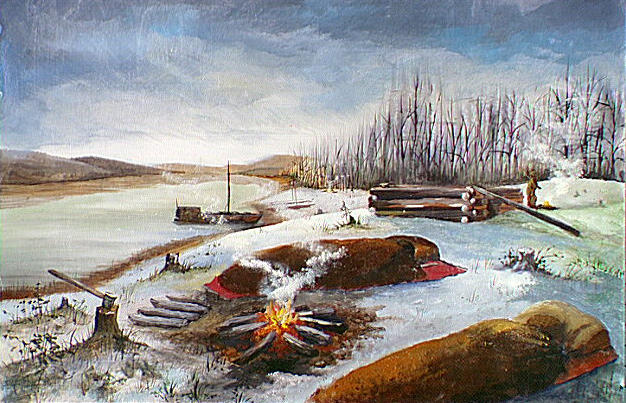At the Fort Mandan construction site, the day is cold and snowy. Lewis leads a group to gather chimney stones and returns late after two hours in the icy river dragging a loaded pirogue across a sandbar. At the fort, the barge is threatened by ice, and Clark learns about the Assiniboine People from a visiting chief.
Gathering Chimney Stones
Capt. Lewis & 6 men went in the pearogue [pirogue] up the River through the Ice to the first village of the Mandens [Mandans] after Stone for the backs of our Chimneys.
—John Ordway
Unloading the Barge
Snowey morning the Ice run considerable fast in the river. we unlaoded the boat for fear the Ice would take it off. we put the loading in the Store house, all though it was not finished, but we continued the work
—John Ordway
Ice and Frostbite
Capt. Lewis returned with his party towards evening much fatigued. they got fast on a Sand bar &l had to be out in the water abto. 2 hours. the Ice running against their legs. their close frooze on them. one of them got 1 of his feet frost bit. it hapned that they had Some whiskey with them to revive their Spirits.
—John Ordway
The Assiniboines
The [Assiniboine] nation Consists of about 600 men, hunt in the Plains & winter and trade on the Ossiniboin River, they are Decendants of the Siaux [Sioux] and Speake their language, they Come to the nations to this quarter to trade or (make preasthts) for horses
—William Clark
Weather Diary
Ther. at rise
Weather Wind at rise
Thert. at 4 P.M. Weather Wind at 4 P.M. River 18 snow S E 18 cloudy after snow S E fall 1 ft ½ in large quanty of drift ice running this morning the river has every appearance of closing for winter
—Meriwether Lewis[1]To assist the reader, the editor of this web page has omitted the date column, merged the “River” columns, and spelled out some abbreviations.
Fort Mandan is a High Potential Historic Site along the Lewis and Clark National Historic Trail managed by the U.S. National Park Service. The North Dakota Department of Parks and Recreation manages a modern reconstruction and the Lewis and Clark Interpretive Center located at US Hwy 83 and ND Hwy 200A.
Knife River Indian Villages National Historic Site is a High Potential Historic Site along the Lewis and Clark National Historic Trail managed by the U.S. National Park Service. A unit of the National Park System, the site is located at 564 County Road 37, one-half mile north of Stanton, North Dakota. It has exhibits, trails, and a visitor center.
Notes
| ↑1 | To assist the reader, the editor of this web page has omitted the date column, merged the “River” columns, and spelled out some abbreviations. |
|---|
Experience the Lewis and Clark Trail
The Lewis and Clark Trail Experience—our sister site at lewisandclark.travel—connects the world to people and places on the Lewis and Clark Trail.
Discover More
- The Lewis and Clark Expedition: Day by Day by Gary E. Moulton (University of Nebraska Press, 2018). The story in prose, 14 May 1804–23 September 1806.
- The Lewis and Clark Journals: An American Epic of Discovery (abridged) by Gary E. Moulton (University of Nebraska Press, 2003). Selected journal excerpts, 14 May 1804–23 September 1806.
- The Lewis and Clark Journals. by Gary E. Moulton (University of Nebraska Press, 1983–2001). The complete story in 13 volumes.




